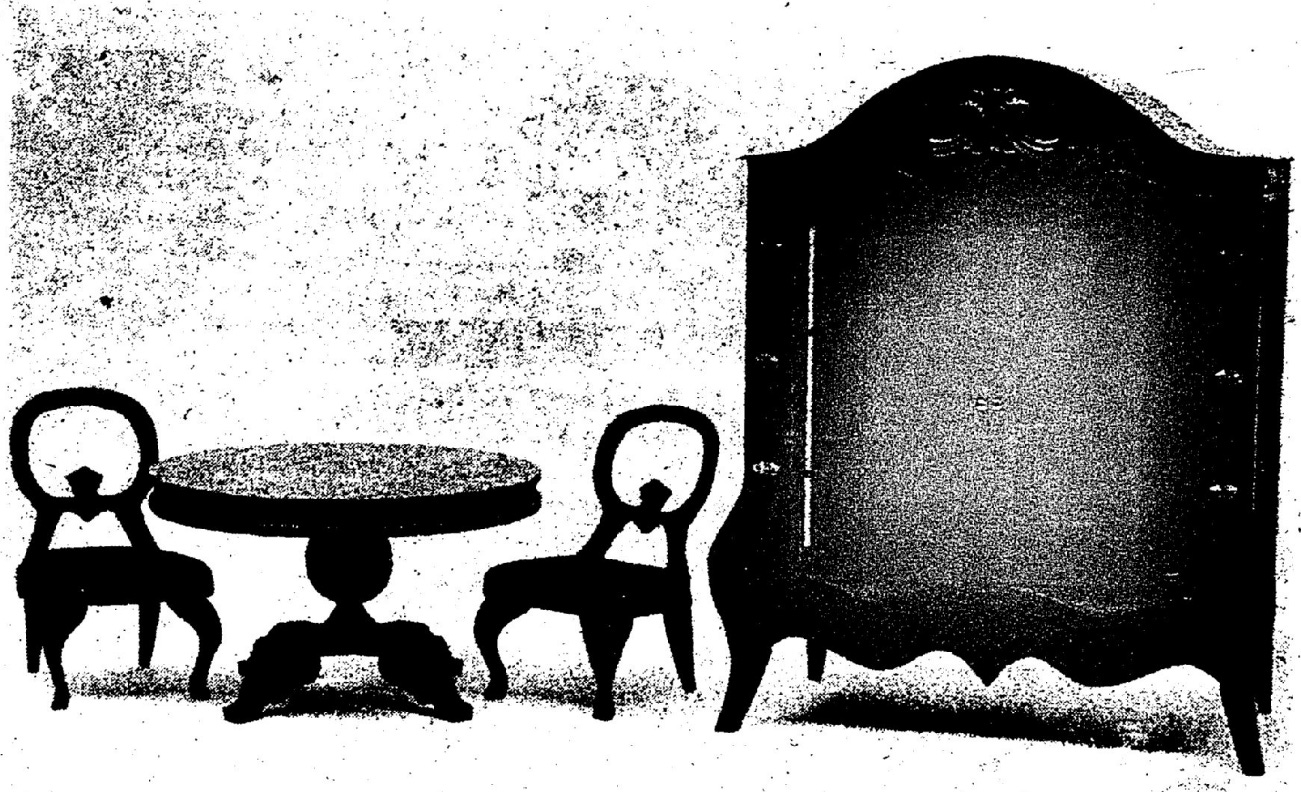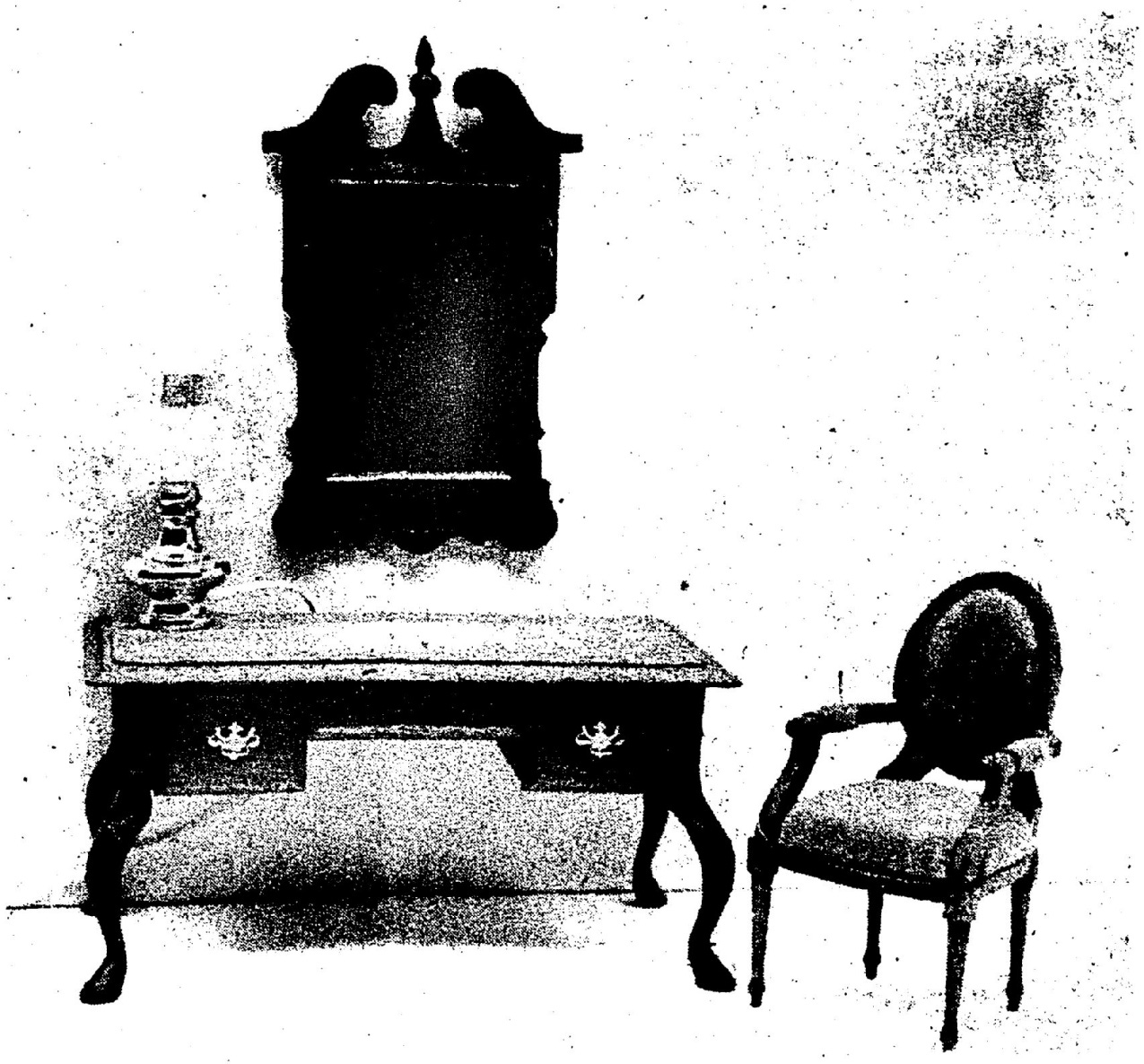"Woody Marceil is big in miniature field" from the September 11, 1975 Door County Advocate
By JEANNE OYEN
Woody Marceil thinks small. It's his business. This house he's working on will be complete to every exterior and interior detail and will take about a thousand hours to complete.
Woody Marceil is big in miniature field
By JEANNE OYEN
As you wind up to the crest of the hill on Peterson Road you come upon a beautiful chalet style house that seems to belong to the landscape. You feel transported to some enchanted alpine scene as you gaze on this charming home nestled among a grove of trees. From this lofty spot you expect to sight at any moment a great soaring eagle or hawk. With a kind of wonder I realized that here in this high place which would have made a perfect setting for a storybook giant I would meet a man who is known as a master of the miniature. For this is where Woodrow Marceil, or Woody as he prefers to be called, works his special kind of magic, transforming small blocks of wood into Lilliputian masterpieces.
The Marceils, Woody, his wife Helen and son Glenn came to Door county about seven years ago from Green Bay and spent several summers in Fish Creek operating their shop, Woody's, which featured his miniatures and other fine handcrafted items.
Woody continued to earn the family income as an insurance broker. He still is involved in this field but pleased that he now has more time to work with his other avocation of miniature making.
About three years ago after selling the shop Woody decided to design his own home with space for a workshop included. When this home was completed they moved as permanent residents to Door county.
Helen Marceil is very much a part of this family business venture; she handles all the correspondence and mails out the catalogs. These are sent upon request for a fee of $2 to interested collectors. She often selects the very tiny print and velvet fabrics needed for rugs and for upholstering the small pieces of furniture. She protested that she is "not good with her hands" but I noticed that while we chatted she worked diligently on the postage stamp size squares of a patchwork quilt destined to cover one of Woody's dollhouse beds.
Their son Glenn a registered pharmacist, is employed at John's Walgreen Agency Drugstore in Sturgeon Bay. But, like father like son, he designed and built almost singlehanded his own woodland home. Proudly Woody and Helen point out his nearly completed modified A frame house which is just a few feet away down the path past a clump of wild flowers. It too commands a breathtaking panoramic view.
Then as we sat talking in their comfortable contemporary living room with its high vaulted cathedral ceiling, so cool and airy with a fresh breeze blowing up from the bay, I could feel this family's special sense of beauty. Woody pointed out a handsome, almost mythological looking Chinese Lion, carved by son Glen; and modestly admitted that he himself did the floral in soft pastels and a lifelike sketch of John Kennedy.
When I asked how he had become interested in making miniatures Woody explained that as a young man he had made several pieces of furniture and enjoyed working with woods. He pointed out two occasional tables and a modern cabinet with clean simple lines. "But," he chuckled "You can only use so much furniture."
So, because he still enjoyed creating fine pieces of furniture, he decided to try making them in miniature. From this developed an absorbing new interest and vocation. He read everything he could find that related to miniature making as well as its history and numerous books and articles on furniture designing, style and history. There is not a great deal written on miniature making (most miniature makers are much too involved in the actual creating of their work to have time to also write books about it." What is mostly available are how-to books for amateurs interested in making a more crude type of simple doll house furniture.
Woody laughs recalling an elderly lady who, admiring his work, turned to her retired husband and suggested that he "take up" miniature making as a hobby. "That's a little like taking up brain surgery. Really fine work demands years of experience and skill," remarked Woody.
As he warmed to his subject I realized what a wealth of information he had amassed. He explained that miniature making dates back to the late Middle Ages in Europe and Russia. In the 14th and 15th Century wealthy kings and nobles often commissioned fine dollhouses to be built for their children. The more beautiful and unique the house and its furnishings, the more pleasure these royal patrons would have in showing it off to their friends and neighbors.
A truly exquisite house became a real status symbol; and for people of that class, money was no object. Just as there were guilds, in those times, for workmen in every craft such as cabinet making or silver engraving so too there were guilds in miniature making. But there was not just one guild for miniature makers, there was a special one devoted only to making the miniature frames of furniture, another designated for upholsterers, yet another made the tiny handcrafted, silver plate to adorn the minute royal tables, and so on.
Each guild of artisans was an exclusive and specialized group commissioned to work on one particular tiny segment. Since there are no longer any royal wealthy patrons to commission this kind of fine hand work the number of people involved in this delicate art has dwindled with each passing year. Woody is understandably pleased that his son Glenn has also expressed interest in his work and has learned many of his father's techniques. But now the time had come to see the actual workshop.
As I entered the modem well equipped shop with its wide picture windows framing the green pastoral hills beyond I felt once again as if I were walking into the world of Hans Christian Anderson. There in the middle of the shop stood a carousel with a bright red and white striped canopy shading a prancing pony in the center. Arranged around the edge of the circular platform was a splendid display of gaily decorated circus wagons.
Each one is made just as an authentic full scale wagon is constructed, complete with leather straps and a brake that really works. Suddenly a black shape whisked past. That was Sauron, Glenn's appropriately named cat, who meowed disdainfully at being disturbed in his afternoon nap.
On one wall of the shop are displayed various doll houses and specially designed boxes to frame miniature rooms. On the opposite wall are shelves filled with Colonial, Queen Anne, Victorian and many different styles of miniature furniture, all on a scale of one inch to the foot. Woody took down a delicate Victorian chair and pointed out the open space where most chairs have a backrest. Victorian ladies and gentlemen were expected to sit up ramrod straight, therefore no backrest. There was no crossbar between the front legs to rest your feet upon either but that Woody explained was to leave room for the ladies' hoops to slip through.
Next he took down several Louis XIV tables and explained how each of the four delicately curved legs is made from a separate block of wood and that all four must be an exact match. I stroked the smooth wood tops made of such exotic material as Tulip wood, satin-wood, rosewood and purple heart. I moved on to admire a curved front glass paneled Queen Anne cabinet and a rich gold velvet chaise lounge. Next there was a lyre table with a birdseye maple top that I had mistaken for marble. There was even a complete modem kitchen with drawers and cabinets that opened and closed.
Then as if he had deliberately saved the best for last, Woody casually directed my attention to a large partially completed house on his work bench at the far end of the shop. There stood a magnificent three story Victorian mansion with a sweeping bay of windows on the front. Mosaics of stained glass colored the upper panes of its many tall stately windows. From inside the light of its many-tiered crystal chandeliers shimmered invitingly. Each work bench at the far end of the shop. There stood a magnificent three story Victorian mansion with a sweeping bay of windows on the front. Mosaics of stained glass colored the upper panes of its many tall stately windows. From inside the light of its many-tiered crystal chandeliers shimmered invitingly. Each chandelier of crystal beads suspended from hand made brass fittings was a small masterpiece. In the living room a parquet floor of tiny wood blocks extended into the front bay area where an inlaid sunburst design was centered.
A handsome paneled wall of mahogany flanked the rosewood fireplace framed in tiny tiles. On the opposite wall, massive wooden sliding doors, also beautifully paneled, slid back and forth mechanically disappearing into the walls at a touch of their maker. Real silk damask lined the beamed ceiling. Richly flocked wallpaper, its design in perfect scale, covered the walls above the wainscoting. A curved alcove in the library, two staircases with fine lattice-like wood trim and sweeping balustrades were just a few of the many fine features of this marvelous house.
I only knew that if I were five inches tall I would surely love to have a lease on that house. Woody assured me that even more exciting features were planned for this splendid period structure. Specially built furniture, including a gothic king size Victorian bed and an oversize banquet table would be designed, as well as an ice box and authentic telephone.
I could see why he preferred to promote his work only through catalog sales and appointments with serious collectors, for I am sure he could spend all his time just showing his wonderful creations to wide eyed sightseers. And then he would never be able to have time enough to finish that exquisite house.
Although 1 didn't even dare to ask what the price of an architectural wonder like that Victorian one would be, I realized that we adults often spend far too much money on junk for our children. One of Woody's more moderately priced houses or sets of furniture, while more expensive than the average toy store Made-in-HongKong merchandise, would certainly be a better investment. He's never had a piece of furniture sent back to him for repair because it is so well constructed. Surely such collector's items could only increase in value with time, and besides what an invaluable treasure for each succeeding generation of children to inherit.
Finally, as I turned reluctantly to leave this modern Geppetto's work shop, I realized I had been so absorbed in admiring the work of his talented fingers I had paid little attention to his own physical attributes. I think he was of medium stature, but just as I had been awed by the setting he had chosen for his work, I also felt I had met a true giant in his field.
Examples of Woody Marceil's miniature mastery. To give an idea of size, the sofa is about five inches wide. Woody has done many circus wagons and an authentic Wells Fargo stagecoach.
Courtesy of the Door County Library Newspaper Archive







